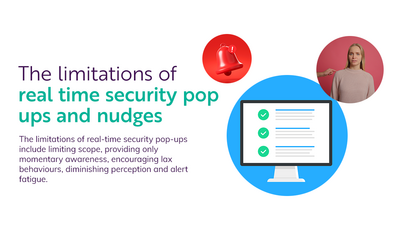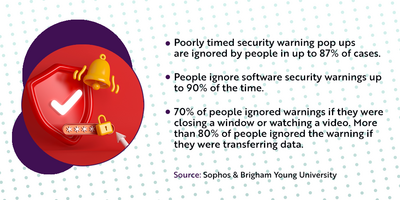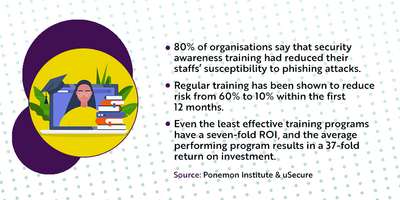
- Employee awareness
- 5 min read

In the battle against cyber threats such as phishing and ransomware, some organisations have turned to real-time security pop-ups or nudges to protect their employees. These pop-ups appear at the moment of vulnerability, providing warnings and guidance.
While they may seem like a practical solution, latest trends and studies suggest that targeted and engaging cyber security training and awareness materials are far more effective in building a long-term resilient workforce.

This article explores the limitations of real-time security pop-ups and emphasises the importance of comprehensive training for mitigating cyber risks.
Nudges in cybersecurity can be valuable interventions to guide individuals towards making more secure decisions. However, for nudges to be truly effective, they need to be supported by engaging training and awareness initiatives.
Nudges need supporting material: While nudges can prompt individuals to reconsider their security choices, they may not provide the necessary knowledge or understanding of why certain actions are important. Engaging training programs can fill this gap by providing individuals with a comprehensive understanding of cybersecurity risks and best practices. These programs can educate users about various threats, such as how cyber criminals use deepfakes in cyber attacks, and help them grasp the potential consequences of their actions or inactions.
Training and awareness initiatives complement nudges by empowering individuals to make informed decisions and take proactive measures to protect their security and privacy. By combining nudges with training and awareness, individuals can develop a deeper understanding of the risks they face and gain the necessary skills to implement secure practices effectively.
Nudges alone don't build a strong security culture: Also, awareness campaigns play a crucial role in making individuals conscious of the importance of security and privacy. By raising awareness about the prevalence of cyber threats and the potential impact on personal and organisational well-being, individuals are more likely to value and prioritise their security.
What happens when nudges don't exist?: Furthermore, training and awareness programs can reinforce the effectiveness of nudges. By repeatedly exposing individuals to security concepts and best practices, these initiatives can strengthen the impact of nudges over time. Consistent reinforcement ensures that individuals internalise security behaviours, making them more likely to adopt and maintain secure habits even in the absence of explicit nudges.
Together, nudges, training, and awareness form a comprehensive approach to promote robust cyber security practices and protect individuals and organisations from ever-evolving threats. However, nudges alone have limitations.
By considering the limitations of real-time security pop-ups, organisations can better understand the importance of comprehensive training and awareness programs that provide a solid foundation of knowledge, foster long-term retention, and promote behavioural change.

These initiatives, when combined with targeted and engaging materials, can empower employees to make informed decisions and effectively mitigate the risks associated with phishing, ransomware, and other cyber threats.
1. Momentary Awareness
Real-time security pop-ups only provide momentary awareness and guidance during specific incidents. Once the pop-up is dismissed, employees may quickly forget the details, making it difficult to retain knowledge and apply it consistently in the future. It is also a sign that your organisation’s training and awareness materials have not been targeted or effective enough to avoid the need for active intervention.
Real-time security pop-ups offer a brief moment of awareness, but they often fail to leave a lasting impact on employees' understanding of cyber threats. The fleeting nature of these alerts makes it challenging for individuals to retain the information and apply it consistently.
2. Limited Scope
Pop-ups generally focus on immediate threats like suspicious links or attachments. However, cyber threats are constantly evolving, and attackers are becoming increasingly sophisticated. Real-time pop-ups may not cover the breadth of tactics employed by cyber criminals, leaving employees vulnerable to new and emerging threats.
Imagine your employees become accustomed to real-time security pop-ups being the only line of defence or quality check for potentially harmful security behaviours … over time, accepting and dismissing pop-ups will become second nature whilst cyber threats aimed at bypassing nudges devastate without ever being noticed.
Real-time security pop-ups typically address known threats and may not encompass the full range of attack vectors. As cyber criminals continue to develop new techniques, relying solely on pop-ups can leave organisations susceptible to emerging threats.
3. Alert Fatigue
Frequent pop-ups can lead to alert fatigue, where employees become desensitised to warnings and treat them as nuisances. This can result in important security alerts being disregarded or dismissed without proper attention, compromising the overall effectiveness of the pop-up system.
Alert fatigue is a significant concern when relying solely on real-time security pop-ups. Employees may become overwhelmed with frequent alerts, leading to a disregard for warnings and an increased risk of overlooking genuine threats.
This is one of the biggest issues with cyber security nudges. It is all well and good installing a system that you would like to see as your final security check in all actions, but if that system starts feeding into unsafe behaviours and, in the end, effectively encourages them – you will be creating larger issues for yourself than if you delivered effective knowledge development beforehand.
4. Lax behaviours
If employees are aware that your organisation now utilises a nudge system of real-time security pop-ups, how do you suppose this will influence their actions? Will they get lax with their behaviours if they believe a system is in place to catch them if they fall? What if the nudge system is not yet ready for a specific action and has nothing built in to prevent it.
Real-time security pop ups can create a false sense of security for employees who are looking for an easy to solution. Instead of being active security advocates, your employees will become dependent on a system that may itself have security gaps.
5. Diminished perception of risk
With a constant influx of pop-ups, employees may begin to perceive every alert as low-priority or inconsequential. This perception can lead to complacency, causing critical security warnings to be overlooked or not taken seriously.
This is separate to alert fatigue as employees still accept and acknowledge them but if they become as frequent as an advert before a video, how quickly will employees learn to subconsciously fade them out?
6. Ineffectiveness in prioritisation
Frequent pop-ups often lack contextual information, leading to difficulties in distinguishing between urgent and non-urgent alerts. This lack of prioritisation guidance can cause employees to also dismiss or ignore potentially significant security threats.
In the end, you may end up needing to teach employees how to assess and deal with the different pop-ups you have installed – adding another unnecessary step to your security culture and employee development program.
7. Negative user experience
Excessive pop-ups can disrupt workflow and productivity, creating frustration among employees. The whole goal of cyber security training and awareness is to make safe security behaviours a part of an employee’s natural behaviours. If you are constantly disrupting your employees’ behaviours with cynical pop-ups, you are sticking a wedge into natural processes.
As a result, employees may develop a negative association with the pop-up system, leading to a disregard for future alerts, even when they are valid. This could lead to bigger security issues than if you just trained and trusted your employees.

While real-time security pop-ups have their place in an organisation's security arsenal, they are not a comprehensive solution.
To effectively combat cyber threats like phishing and ransomware, organisations must invest in targeted and engaging cyber security training and awareness materials.
By providing employees with the knowledge, skills, and tools necessary to identify and respond to potential threats, organisations can build a resilient workforce capable of adapting to the ever-changing cyber landscape.
Training programs that promote long-term retention, adaptive learning, and behavioural change are essential in creating a culture of cyber security awareness and protection.
If you would like more information about how The Security Company can help you to deliver targeted cyber security training or how we help clients with long term security culture change ... please contact our Head of Business Development and Sales, Jenny Mandley.
The Security Company's vast library of customised and non-customised products and services are tailored for small, medium and large organisations and are available in a variety of languages. We also offer bespoke solutions for organisations that desire training and awareness materials built from the ground up.



© The Security Company (International) Limited 2023
Office One, 1 Coldbath Square, London, EC1R 5HL, UK
Company registration No: 3703393
VAT No: 385 8337 51


